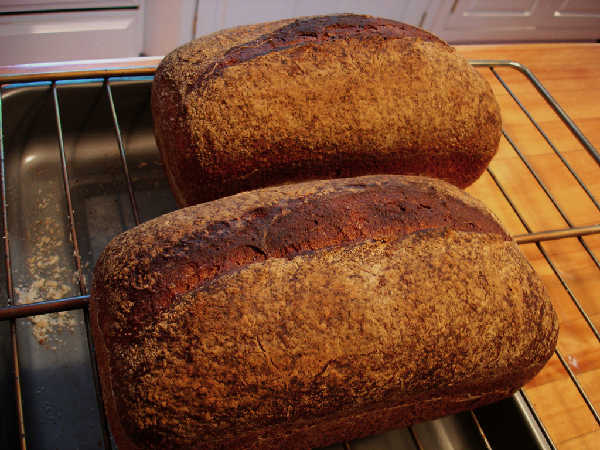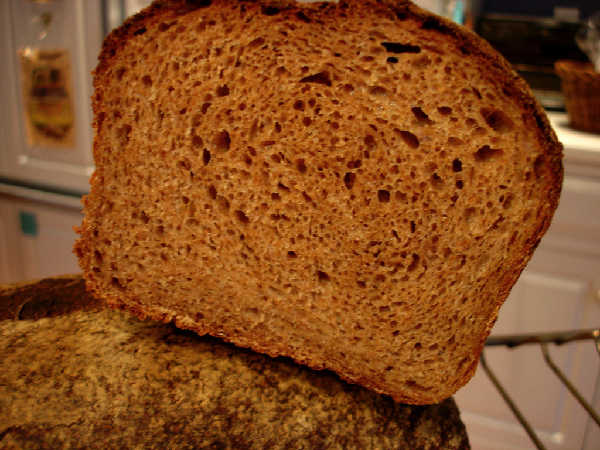
This bread is an attempt to improve on the results from a previous blog entry. This one also has a spelt levain, but it was designed to rise overnight with only a small quantity of 90% hydration white flour starter added. The levain was added to the dough when it was not very ripe, before it had peaked and dipped. The percentage of fermented flour is about 32%, but the less ripe starter results in flavor and dough handling more like what you would expect if you used a lower percentage of fermented flour. The whole spelt flour contributes a characteristic nutty, slightly sweet flavor to the bread. I was very happy with the flavor resulting from this combination of flours and plan to use it more often for this bread and for my favorite mixed grain miche recipe. The hydration is about 83%, which for a whole grain bread is not enough to make it very wet or difficult to handle. However, it is a slightly slack and sticky dough. It should spread out only a little bit after sitting on the counter, not like a very wet ciabatta dough that might spread out more quickly and more or less pour out of the bowl until it has been folded more.

I have posted some photos, videos of my version of doing a "French Fold" and of periodic "Folding" during bulk fermentation, and also a spreadsheet with some further information such as baker's percentages, fermented flour percentages, and hydration.
Ingredients:
Firm Levain:
- 90% hydration storage starter 11g (0.4 oz) (use any healthy active sourdough starter here, ideally contributing the same amount of fermented flour, e.g. use more like 9 grams of 60% hydration firm starter)
- whole spelt flour 298g (10.5 oz)
- water 184g (6.5 oz)
Overnight Soak Ingredients:
- malt syrup 40g (1.4 oz)
- diastatic malt powder 5g (.16 oz)
- whole red wheat flour 397g (14 oz)
- whole white wheat flour 170g (6 oz)
- KA rye blend 57g (2 oz)
- water 581g (20.5 oz)
Final Dough Ingredients:
- overnight soak from above
- firm levain from above
- salt 17g (.6 oz)
- olive oil 28g (1 oz)
Levain
Mix levain ingredients the night before you plan to bake. The levain is designed to rise by about double in 10 hours at a temperature of 75F. Adjust accordingly if you have different temperatures. It is not a problem if the levain rises by more than double or peaks and dips. However, if it is allowed to ripen too much, you may experience a sluggish rise or other symptoms similar to overproofing sourdough, since the amount of fermented flour contributed by this recipe is fairly high. I added this levain when it had a little more than doubled, but it was clearly not at its peak yet.
Overnight Soak
Mix all the flour and other dry ingredients for the overnight soak together well, so they are fully integrated and uniformly distributed. Mix the malt syrup and water so that the malt syrup is fully dissolved and well distributed in the water. Pour the water into the bowl and use a dough scraper to work around the bowl and mix the flour and water well enough to fully and uniformly hydrate the flour. This should be very easy and take only a couple of minutes of mixing. You can also use a mixer, but use very slow settings and do not overdo it. The idea is to just mix the ingredients. Cover and put in the refrigerator.
Mix Final Dough (next morning)
Chop up the levain into small pieces about the size of marshmallows. Wet your hands and rub the counter with water. Pour the dough from the overnight soak out onto the counter and spread it out like a pizza. Distribute the pieces of levain evenly across the dough. Press them in with the heel of you hand. Roll up the dough in one direction, then the other. Allow it to rest for a few minutes. Again wet your hands and the counter if it needs it. Spread out the dough again like a pizza. Evenly spread the salt and the oil over the surface of the dough and press it into the dough again with the heel of your hand. Roll up the dough in one direction, then the other. Let it rest a few minutes. Spread it out one more time like a pizza. Work across the dough pressing the heels of your hands deep into the dough to integrate any oil and salt that may not have already been well integrated into the dough. Roll up the dough in one direction, then the other.
Let rest for 15 minutes.
Do two or three "French Folds", as shown in the video. Note that this is a good technique for developing the gluten in a wet dough that may not respond well to conventional kneading. Also, note, when I say two or three, I mean literally about 10 seconds, like two repetitions of the motion, as shown in the video. That is all the "kneading" that was done to make this bread. Place the dough in a covered bucket or bowl to rise.
Bulk Fermentation and Periodic Folding
The dough should rise by double in about 4 hours at 75F, but the folding will degas the dough somewhat, so lean toward less than double, depending on how much you are degassing the dough while folding. Also, adjust accordingly if your temperature is different or your starter is faster or slower. Try not to let this dough ferment too long. The high percentage of fermented flour in the dough and the spelt flour will conspire against you if you allow the dough to rise for too long. If in doubt, stop the bulk fermentation and go on to shaping, even if the dough doesn't rise by double.
Fold the dough about three times approximately on the hour, as shown in the "Folding" video. If the dough appears to be wet enough to relax significantly before one hour, then fold sooner. If the dough appears to be fairly stiff and holding its shape or is hard to stretch when you fold it, then fold less often or fewer times.
Shaping
Create sandwich loaves using a typical batard technique or whatever method you prefer. Place loaves in typical loaf pans that are about 9 inches long by 4.5 inches wide. I sprayed the pans lightly with oil beforehand to avoid any sticking.
Final Proof
Allow loaves to rise by roughly double in about 2.5 hours at 75F. Again, adjust your proofing time as necessary for different temperatures or different starter. Once again, avoid overproofing, which is easier to do inadvertently with less tolerant spelt flour and the higher percentage of fermented flour in this recipe.
Bake
I slashed the loaves and baked them from a cold start for 1 hour and 5 minutes at 400F after proofing for 2 hours and 15 minutes. Although the dough is not as wet as some, it still should be thoroughly baked. Otherwise the crumb will be overly moist and the crust will become soggy.
Cool
When the loaves are done, remove them from the pans and allow them to cool on a rack. Do not cut into them, if you can resist, at least until they are no longer warm to the touch.
Results
I was very pleased with the flavor of this bread. The sourdough flavor from the spelt starter is delicious, there is no bitter flavor of whole wheat that I can detect, and the spelt adds a unique and mild flavor. The bread toasts very well and carries any type of topping, since the crumb is open and light but not so irregular that honey or other wet ingredients fall right through it.


















